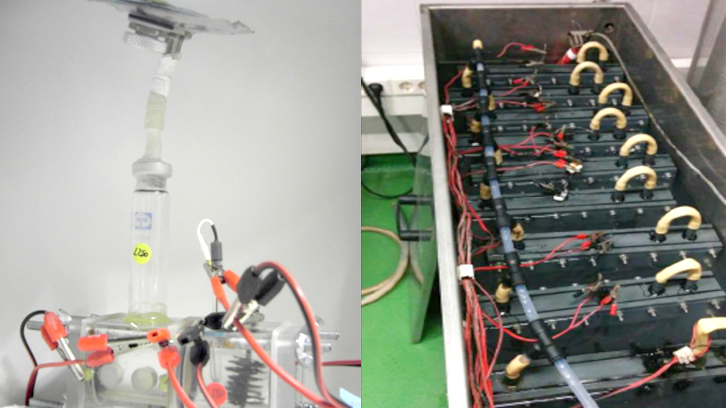From industrial wastewater to green hydrogen with microbial electrolysis cells

The GENOCOV research group investigates microbial electrolysis cells, systems that treat wastewater while generating resources. One of the key practical aspects in the performance and feasibility of these systems is the cathode material, where hydrogen is generated. In this study, they have tested nickel foam as a cathode for the first time and have achieved the highest hydrogen production ever recorded on a pilot scale.
In a world where climate change is a reality, sustainable wastewater management is more crucial than ever. Traditional wastewater treatment methods, while effective, require significant amounts of energy, pushing us to seek innovative solutions. Additionally, wastewater contains a large amount of stored energy in its components. 21st-century environmental engineering offers a new approach that views wastewater not as waste, but as a valuable resource from which both materials and energy can be recovered.
One particularly promising technology is microbial electrolysis cells (MECs), a type of bioelectrochemical system (BES). These systems treat wastewater while simultaneously generating resources (electricity, chemicals, hydrogen...) by utilizing specific microorganisms present in the wastewater: the electroactive microorganisms. In MECs, specifically, we have a pair of interconnected electrodes surrounded by two liquids: wastewater and an electrolyte solution. On the electrode in contact with the wastewater (the anode), electroactive microorganisms grow and are capable of oxidizing the organic matter in the wastewater, while at the other electrode (the cathode), the electrons generated are used to produce hydrogen.
The GENOCOV research group from the Chemical, Biological, and Environmental Engineering Department (DEQBA) has been investigating this technology for over 15 years. Although the results achieved with MECs in the lab have been very promising, their viability on a large scale remains unknown. Most research on these systems focuses on fundamental aspects in controlled environments, using small reactors and easily biodegradable synthetic substrates, overlooking critical technical issues at real-world scale. For instance, one key practical factor in the performance and viability of MECs is the electrode material, particularly the cathode, as this is where hydrogen is generated. Platinum is the most common catalyst for electrochemical reactions that produce hydrogen, but its high cost makes it an economic challenge for this application. Therefore, exploring more affordable cathode materials is essential.
In this study, nickel foam in a large-scale MEC (over 150 liters) was tested for the first time, treating industrial wastewater, and compared it with stainless-steel wool, a material previously studied by the research group. The results showed continuous hydrogen production for over eighty days, removing a significant fraction of the organic matter in the wastewater, thus achieving wastewater treatment and hydrogen recovery simultaneously. Thanks to the nickel foam cathode, the highest hydrogen production ever recorded at a pilot scale was achieved (19.07 ± 0.46 L H2 m-2 d-1), which was three times higher than that obtained with the traditional stainless-steel cathode. Ultimately, this study is another step towards bringing MECs to industrial scale, demonstrating that under certain conditions, they can be net energy producer. This makes them a promising solution for wastewater treatment, waste valorization, and the circular economy.
Óscar Guerrero Sodric, Juan Antonio Baeza Labat and Albert Guisasola Canudas
Research group on biological treatment of liquid and gaseous effluents, GENOCOV
Chemical, Biological and Environmental Engineering Department
School of Engineering
Universitat Autònoma de Barcelona
oscar.guerrero@uab.cat, albert.guisasola@uab.cat, juanantonio.baeza@uab.cat
References
Oscar Guerrero-Sodric, Juan Antonio Baeza and Albert Guisasola. Enhancing bioelectrochemical hydrogen production from industrial wastewater using Ni-foam cathodes in a microbial electrolysis cell pilot plant, Water Research 256 (2024): 121616. https://doi.org/10.1016/j.watres.2024.121616


